Capability of Diffuse Reflectance Spectroscopy to Predict Soil Water Retention and Related Soil Properties in an Irrigated Lowland District of Southern Italy
Abstract
:1. Introduction
2. Materials and Methods
2.1. Study Area
2.2. Soil Sampling and Analyses
2.3. Statistical Analysis of Soil Properties
2.4. Vis-NIR Spectroscopy
2.5. Multivariate Calibration
3. Results and Discussions
3.1. Soil Properties
3.2. Soil Spectral Characteristics
3.3. Multivariate Calibration
4. Conclusions
Author Contributions
Funding
Acknowledgments
Conflicts of Interest
References
- Zucaro, R. Atlas of Italian Irrigation Systems; Centro Stampa e Riproduzione: Rome, Italy, 2014; p. 174. [Google Scholar]
- International Commission on Irrigation and Drainage. Available online: https://www.icid.org/v_italy.pdf (accessed on 25 July 2019).
- Alvino, A.; Marino, S. Remote Sensing for Irrigation of Horticultural Crops. Horticulturae 2017, 3, 40. [Google Scholar] [CrossRef]
- Abbasi, Y.; Ghanbarian-Alavijeh, B.; Liaghat, A.M.; Shorafa, M. Evaluation of pedotransfer functions for estimating soil water retention curve of saline and saline-alkali soils of Iran. Pedosphere 2011, 2, 230–237. [Google Scholar] [CrossRef]
- White, R.E. Principles and Practices of Soil Science; Blackwell Publishing: Padstow, Cornwall, UK, 2006; p. 363. [Google Scholar]
- Silva, B.M.; da Silva, É.A.; de Oliveira, G.C.; Ferreira, M.M.; Serafim, M.E. Plant-available soil water capacity: Estimation methods and implications. Rev. Bras. Cienc. Solo 2014, 38, 464–475. [Google Scholar] [CrossRef]
- Ferreira, M.I. Stress Coefficients for Soil Water Balance Combined with Water Stress Indicators for Irrigation Scheduling of Woody Crops. Horticulturae 2017, 3, 38. [Google Scholar] [CrossRef]
- White, R.E. Soils for Fine Wines; Oxford University Press: Oxford, NY, USA, 2003; p. 279. [Google Scholar]
- Brady, N.C.; Weil, R.R. The Nature and Properties of Soils; Prentice Hall: Upper Saddle River, NJ, USA, 2002; p. 960. [Google Scholar]
- Vereecken, H.; Weynant, M.; Javaux, M.; Pachepsky, Y.; Schaap, M.G.; van Genuchten, M.T. Using pedotransfer functions to estimate the van Genuchten-Maulem soil hydraulic properties. A review. Vadose Zone J. 2010, 9, 1–26. [Google Scholar] [CrossRef]
- Leone, A.P.; Viscarra-Rossel, A.R.; Amenta, P.; Buondonno, A. Prediction of soil properties with PLSR and vis-NIR spectroscopy: Application to Mediterranean soils from Southern Italy. Curr. Anal. Chem. 2012, 8, 283–299. [Google Scholar] [CrossRef]
- Haghverdi, A.; Ozturk, H.S.; Cornelis, W.M. Revisiting the pseudo continuous pedotransfer function concept: Impact of data quality and data mining method. Geoderma 2014, 226, 31–38. [Google Scholar] [CrossRef]
- Bouma, J. Using soil survey data for quantitative land evaluation. Adv. Soil Sci. 1989, 9, 177–213. [Google Scholar]
- Vereecken, H.; Maes, J.; Feyen, J.; Darius, P. Estimating the soil-moisture retention characteristic from texture, bulk density, and carbon content. Soil Sci. 1989, 148, 389–403. [Google Scholar] [CrossRef]
- Tomasella, J.; Hodnett, M.G. Estimating soil water retention characteristics from limited data in Brazilian Amazonia. Soil Sci. 1998, 163, 190–202. [Google Scholar] [CrossRef]
- Zhao, C.; Shao, M.; Jia, X.; Nasir, M.; Zhang, C. Using pedotransfer functions to estimate soil hydraulic conductivity in the Loess Plateau of China. Catena 2016, 143, 1–6. [Google Scholar] [CrossRef]
- Dobarco, M.R.; Cousin, I.; Le Bas, C.; Martin, M. Pedotransfer functions for predicting available water capacity in French soils, their applicability domain and associated uncertainty. Geoderma 2019, 336, 81–95. [Google Scholar] [CrossRef]
- Ben-Dor, E.; Irons, J.R.; Epema, G.F. Soil reflectance. In Remote Sensing for the Earth Sciences: Manual of Remote Sensing, 3rd ed.; Rencz, A.N., Ed.; Wiley: New York, NY, USA, 1999; Volume 3, pp. 111–188. [Google Scholar]
- Drury, S.A. Image Interpretation in Geology; Chapman & Hall: London, UK, 1993; p. 283. [Google Scholar]
- Milton, E.J. Principles of field spectroscopy. Int. J. Remote Sens. 1987, 12, 1807–1827. [Google Scholar] [CrossRef]
- Viscarra Rossel, R.A.; Walvoort, D.J.J.; McBratney, A.B.; Janik, L.J.; Skjemstad, J.O. Visible, near infrared, mid infrared or combined diffuse reflectance spectroscopy for simultaneous assessment of various soil properties. Geoderma 2006, 131, 59–75. [Google Scholar] [CrossRef]
- Marino, S.; Aria, M.; Basso, B.; Leone, A.P.; Alvino, A. Use of soil and vegetation spectroradiometry to investigate crop water use efficiency of a drip irrigated tomato. Eur. J. Agron. 2014, 59, 67–77. [Google Scholar] [CrossRef]
- Ben-Dor, E.; Inbar, Y.; Chen, Y. The reflectance spectra of organic matter in the visible near-infrared and short wave infrared region (400–2500 nm) during controlled decomposition process. Remote Sens. Environ. 1997, 61, 1–15. [Google Scholar] [CrossRef]
- Stenberg, B.; Viscarra Rossel, R.A.; Mouazen, A.M.; Wetterlind, J. Visible and near infrared spectroscopy in soil science. In Advances in Agronomy; Sparks, D.L., Ed.; Academic Press: Burlington, VT, USA, 2010; Volume 107, pp. 163–215. [Google Scholar]
- Babaeian, E.; Homaee, M.; Vereeckem, H.; Montzka, C.; Norouzi, A.A.; van Genuchten, M.T. A Comparative Study of Multiple Approaches for Predicting the Soil–Water Retention Curve: Hyperspectral Information vs. Basic Soil Properties. Soil Sci. Soc. Am. J. 2015, 79, 1043–1058. [Google Scholar] [CrossRef]
- Sudduth, K.A.; Hummel, J.W. Soil organic matter, CEC and moisture sensing with a portable NIR spectrophotometer. Trans. ASAE 1993, 36, 1571–1582. [Google Scholar] [CrossRef]
- Aïchi, H.; Fouad, Y.; Walter, C.; Viscarra Rossel, R.A.; Chabaane, Z.L.; Sanaa, M. Regional predictions of soil organic carbon content from reflectance measurements. Biosyst. Eng. 2009, 104, 442–446. [Google Scholar] [CrossRef]
- Ingleby, H.R.; Crowe, T.G. Neural network models for predicting organic matter content in Saskatchewan soils. Can. Biosyst. Eng. 2001, 43, 3. [Google Scholar]
- Köppen, W.P. Handbuch Der Klimatologie. Das Geographisca System Der Klimate. In Handbuch Der Klimatologie; Köppen, W., Geiger, G., Eds.; C. Borntraeger Science Publishers: Stuttgart, Germany, 1930; Volume 1, p. 44. [Google Scholar]
- Geoportale Regione Campania. Sistema Informativo Territoriale della Regione Campania. Available online: https://sit2.regione.campania.it/content/carta-utilizzazione-agricola-dei-suoli (accessed on 10 February 2019).
- Di Gennaro, A. I sistemi di terra della Campania; SELCA: Florence, Italy, 2002; p. 63. [Google Scholar]
- MIPAF (Ministero delle Politiche Agricole e Forestali). Metodi di Analisi Chimica del Suolo; Franco Angeli: Milan, Italy, 2000; p. 536.
- MIPAF (Ministero delle Politiche Agricole e Forestali). Metodi di Analisi Fisica del Suolo; Franco Angeli: Milan, Italy, 1998; p. 400.
- Clark, R.N.; Roush, T.L. Reflectance spectroscopy: Quantitative analysis techniques for remote sensing applications. J. Geophys. Res. 1984, 89, 6329–6340. [Google Scholar] [CrossRef]
- Van der Meer, F. Can we map swelling clays with remote sensing? Int. J. Appl. Earth Obs. Geoinf. 1999, 1, 27–35. [Google Scholar] [CrossRef]
- De Jong, S. The anaysis of spectroscopical data to map soil types and soil crusts of Mediterraneas eroded soils. Soil Technol. 1992, 5, 199–211. [Google Scholar] [CrossRef]
- Viscarra Rossel, R.A. ParLeS: Software for chemometric analysis of spectroscopic data. Chemom. Intell. Lab. Syst. 2008, 90, 72–83. [Google Scholar] [CrossRef]
- Eriksson, L.; Johansson, E.; Kettaneh-Wold, N.; Trygg, J.; Wilström, C.; Wold, S. Multi-and Megavariate Data Analysis; Part I-Basic principles and applications; Umetrics Academy: Umeå, Sweden, 2006; p. 425. [Google Scholar]
- Geladi, P.; MacDouglas, D.; Martens, H. Linearization and scatter-correction for near-infrared reflectance spectra of meat. Appl. Spectrosc. 1985, 3, 491–500. [Google Scholar] [CrossRef]
- Barnes, R.J.; Dhanoa, M.S.; Lister, S.J. Standard normal variate transformation and de-trending of near-infrared diffuse reflectance spectra. Appl. Spectrosc. 1989, 43, 772–777. [Google Scholar] [CrossRef]
- Dhanoa, M.S.; Lister, S.L.; Sanderson, R.; Barnes, R.J. The link between multiplicative scatter correction (MSC) and standard normal variate (SNV) transformation of NIR spectra. J. Near Infrared Spec. 1994, 2, 43–47. [Google Scholar] [CrossRef]
- Daubechies, I. Ten Lectures on Wavelets; Society for Industrial and Applied Mathematics: Philadelphia, PA, USA, 1992; p. 341. [Google Scholar]
- Savitzky, A.; Golay, M.J.E. Smoothing and differentiation of data by simplified least squares procedures. Anal. Chem. 1964, 36, 1627–1639. [Google Scholar] [CrossRef]
- Efron, B.; Tibshir, R.J. An Introduction of the Bootstrap, 1st ed.; Chapman and Hall: New York, NY, USA, 1993; p. 436. [Google Scholar]
- Akaike, H. Fitting Autoregressive Models for Prediction. Ann. Inst. Stat. Math. 1969, 21, 243–247. [Google Scholar] [CrossRef]
- Li, B.; Morris, J.; Martin, E.B. Model selection for partial least squares regression. Chemom. Intell. Lab. Syst. 2002, 1, 79–89. [Google Scholar] [CrossRef]
- Williams, P.C. Variables affecting near-infrared reflectance spectroscopic analysis. In Near-Infrared Technology in the Agricultural and Food Industries; Williams, P.C., Norris, K., Eds.; American Association of Cereal Chemists Inc.: St. Paul, MN, USA, 1987; pp. 143–167. [Google Scholar]
- Viscarra Rossel, R.A. Robust modelling of soil diffuse reflectance spectra by bagging-partial least squares regression. J. Near Infrared Spec. 2007, 15, 39–47. [Google Scholar] [CrossRef]
- Ding, J.; Yang, A.; Wang, J.; Sagan, V.; Yu, D. Machine-learning-based quantitative estimation of soil organic carbon content by VIS/NIR spectroscopy. Peer J. 2018, 5714, 1–14. [Google Scholar] [CrossRef]
- Summers, D.; Lewis, M.; Ostendorf, B.; Chittleborough, D. Visible near-infrared reflectance spectroscopy as a predictive indicator of soil properties. Ecol. Indic. 2011, 11, 123–131. [Google Scholar] [CrossRef]
- Leone, A.P. Spettrometria e valutazione della riflettanza spettrale dei suoli nel dominio ottico 400–2500 nm. Riv. Ital. Telerilevamento 2000, 9, 3–28. [Google Scholar]
- Kariuki, P.C.; Wolday, T.; Van der Meer, F. Effectiveness of spectroscopy in identification of swelling indicator clay minerals. Int. J. Remote Sens. 2004, 2, 455–469. [Google Scholar] [CrossRef]
- Bartholomeus, H.M.; Schaepman, M.E.; Kooistra, L.; Stevens, A.; Hoogmoed, W.B.; Spaargaren, O.S.P. Spectral reflectance based indices for soil organic carbon quantification. Geoderma 2008, 145, 28–36. [Google Scholar] [CrossRef]
- Henderson, T.L.; Baumgardner, M.F.; Franzmeier, D.P.; Stott, D.E.; Coster, D.C. High dimensional reflectance analysis of soil organic matter. Soil Sci. Soc. Am. J. 1992, 56, 865–872. [Google Scholar] [CrossRef]
- Galvao, L.S.; Vitorello, I. Role of organic matter in obliterating the effects of iron on spectral reflectance and color of Brazilian tropical soils. Int. J. Remote Sens. 1998, 19, 1969–1979. [Google Scholar] [CrossRef]
- Burger, J.; Geladi, P. Spectral pre-treatments of hyperspectral near infrared images: Analysis of diffuse reflectance scattering. J. Near Infrared Spec. 2007, 15, 29–37. [Google Scholar] [CrossRef]
- Wise, B.M.; Gallagher, N.B.; Bro, R.; Shaver, J.M. PLS Toolbox Version 3.0 for Use with Matlab; Eigenvector Research Inc.: Wenatchee, WA, USA, 2003; p. 171. [Google Scholar]
- Vågen, T.G.; Shepherd, K.D.; Walsh, M.G. Sensing landscape level change in soil fertility following deforestation and conversion in the highlands of Madagascar using Vis-NIR spectroscopy. Geoderma 2006, 133, 281–294. [Google Scholar] [CrossRef]
- Volkan Bilgili, A.; van Es, H.M.; Akbas, A.; Hively, W.D. Visible-near infrared reflectance spectroscopy for assessment of soil properties in a semi-arid area of Turkey. J. Arid Environ. 2010, 74, 229–238. [Google Scholar] [CrossRef]
- Arslan, H.; Tasan, M.; Yildirim, D.; Koksal, E.S.; Cemek, B. Predicting field capacity, wilting point, and other physical properties of soils using hyperspectral reflectance spectroscopy: Two different statistical approaches. Environ. Monit. Assess. 2014, 186, 5077–5088. [Google Scholar] [CrossRef]
- Awiti, A.O.; Walsh, M.G.; Shepherd, K.D.; Kinyamario, J. Soil condition classification using infrared spectroscopy: A proposition for assessment of soil condition along a tropical forest-cropland chronosequence. Geoderma 2008, 143, 73–84. [Google Scholar] [CrossRef]
- Udelhoven, T.; Emmerling, C.; Jarmer, T. Quantitative analysis of soil chemical properties with diffuse reflectance spectrometry and partial least-square regression: A feasibility study. Plant Soil 2003, 251, 319–329. [Google Scholar] [CrossRef]
- McCarty, G.W.; Reeves, J.B., III; Reeves, V.B.; Follett, R.F.; Kimble, J.M. Mid-infrared and near-infrared diffuse reflectance spectroscopy for soil carbon measurement. Soil Sci. Soc. Am. J. 2002, 66, 640–646. [Google Scholar]
- Chang, C.W.; Laird, D.A. Near-infrared reflectance spectroscopic analysis of soil C and N. Soil Sci. 2002, 167, 110–116. [Google Scholar] [CrossRef]
- Islam, K.; Singh, B.; Schwenke, G.; McBratney, A. Evaluation of Vertosol soil fertility using ultra-violet, visible and near-infrared reflectance spectroscopy. In Proceedings of the 3rd Australian New Zealand Soils Conference, Sydney, Australia, 5–9 December 2004; pp. 1–8. [Google Scholar]
- Kooistra, L.; Wanders, J.; Epema, G.F.; Leuven, R.S.E.W.; Wehrens, R.; Buydens, L.M.C. The potential of field spectroscopy for the assessment of sediment properties in river floodplains. Anal. Chim. Acta. 2003, 184, 189–200. [Google Scholar] [CrossRef]
- Dunn, B.W.; Beecher, H.G.; Batten, G.D.; Ciavarella, S. The potential of near-infrared reflectance spectroscopy for soil analysis—A case study from the Riverine Plain of South-Eastern Australia. Aust. J. Exp. Agric. 2002, 42, 607–614. [Google Scholar] [CrossRef]
- Tümsavaș, Z.; Tekin, Y.; Ulusoy, Y.; Mouazen, A.M. Prediction and mapping of soil clay and sand contents using visible and near-infrared spectroscopy. Biosyst. Eng. 2019, 177, 90–100. [Google Scholar] [CrossRef]
- Cozzolino, D.; Morón, A. The potential of near-infrared reflectance spectroscopy to analyse soil chemical and physical characteristics. J. Agric. Sci. Camb. 2003, 140, 65–71. [Google Scholar] [CrossRef]
- Sørensen, L.K.; Dalsgaard, S. Determination of clay and other soil properties by infrared spectroscopy. Soil Sci. Soc. Am. J. 2005, 69, 159–167. [Google Scholar] [CrossRef]

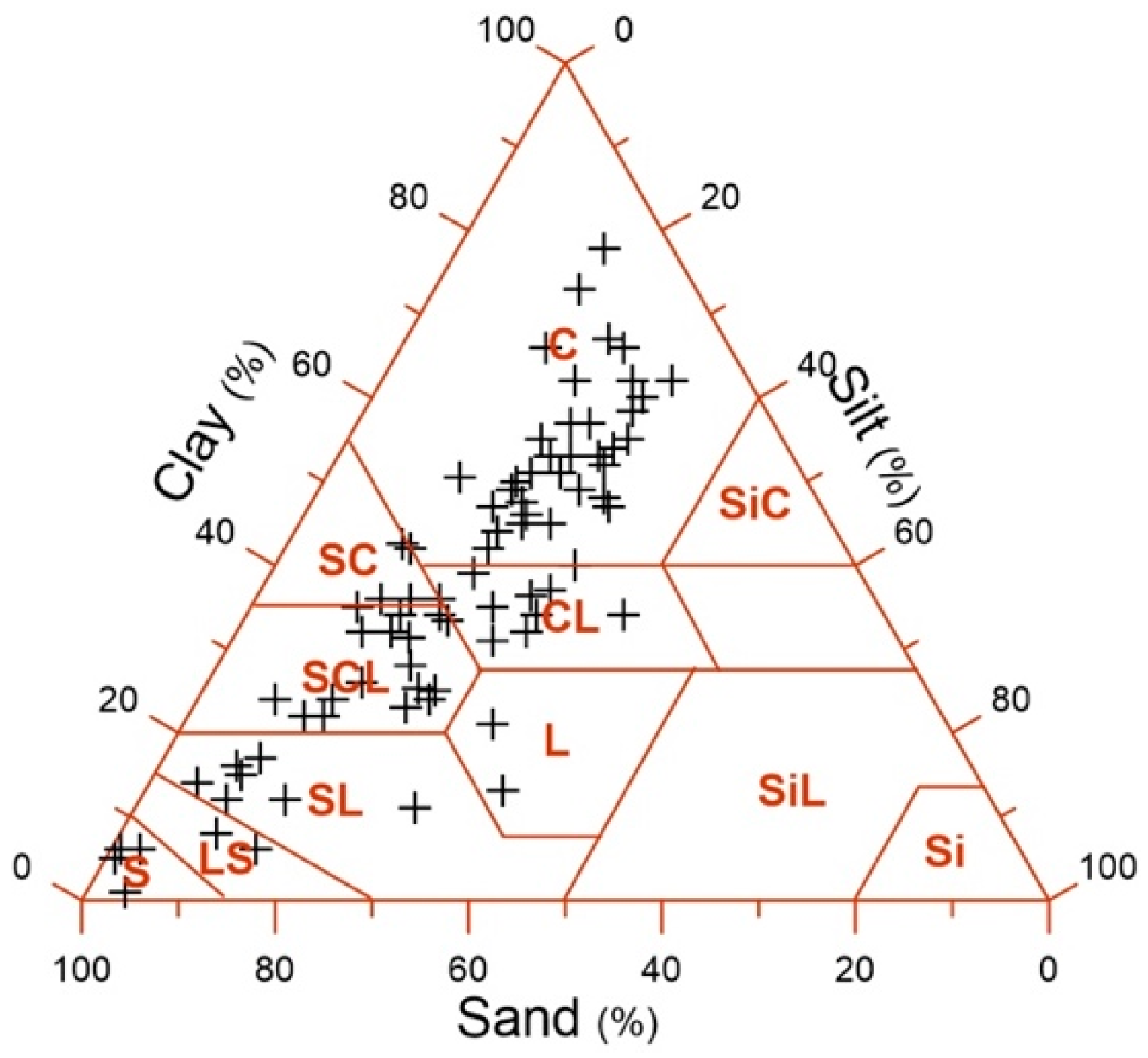
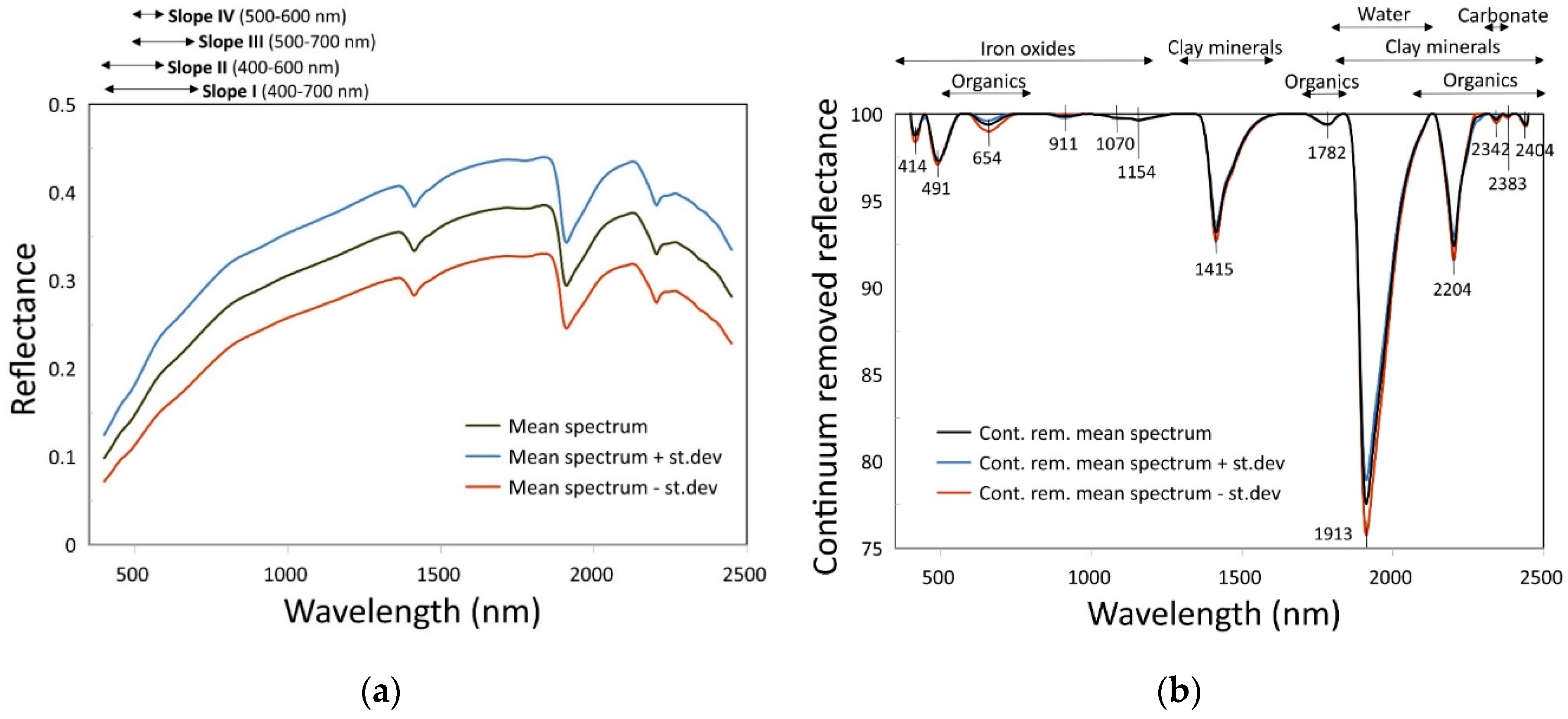
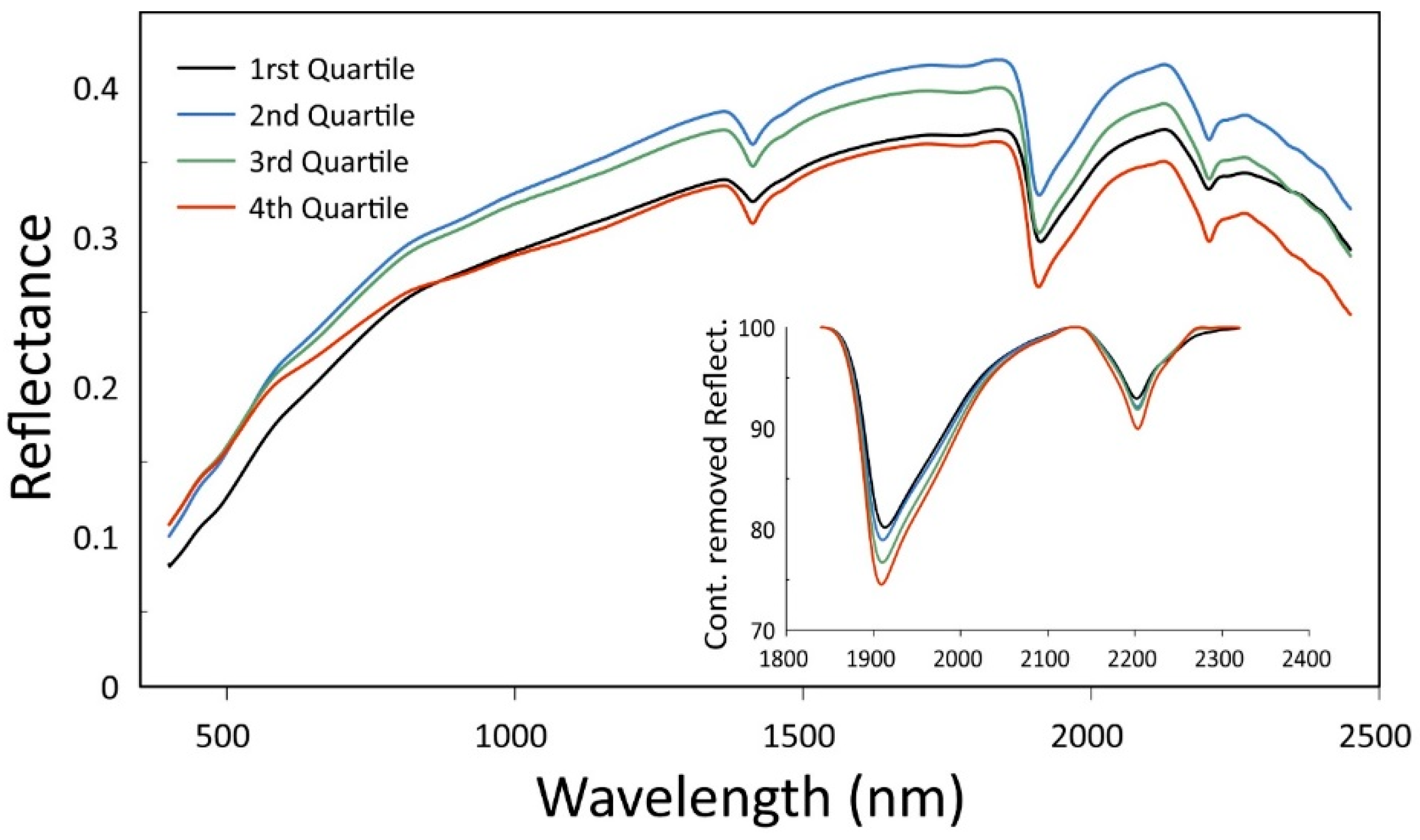
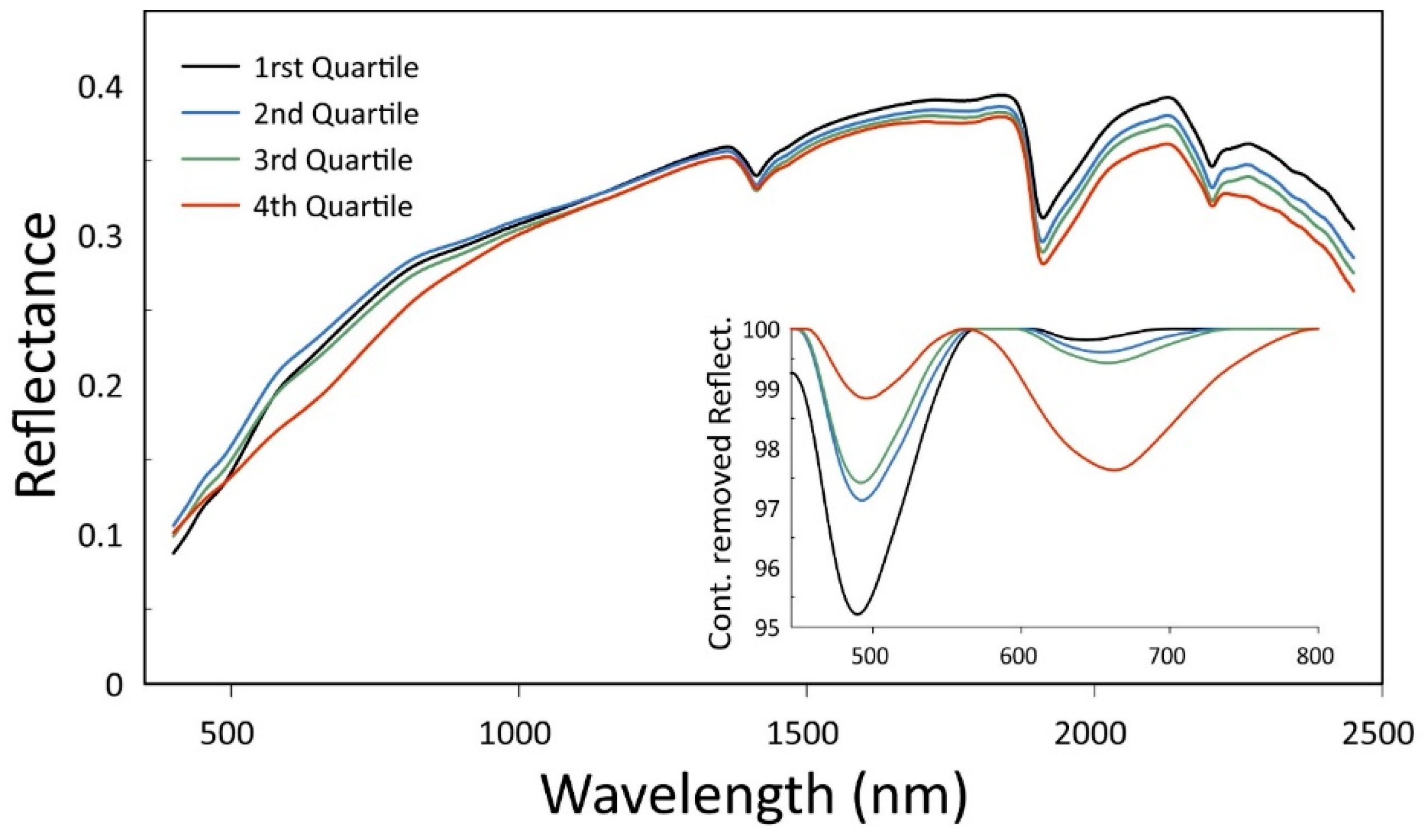
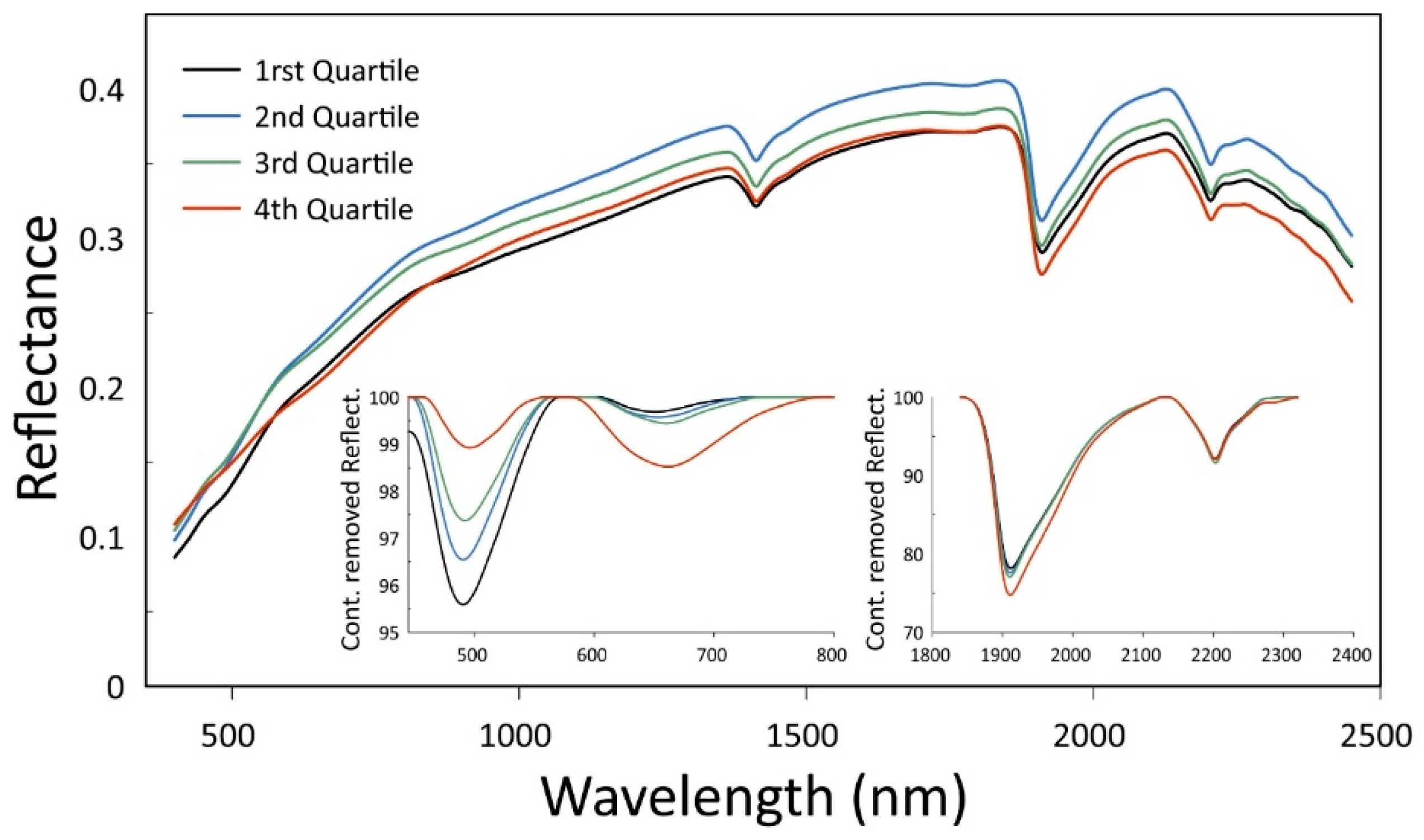
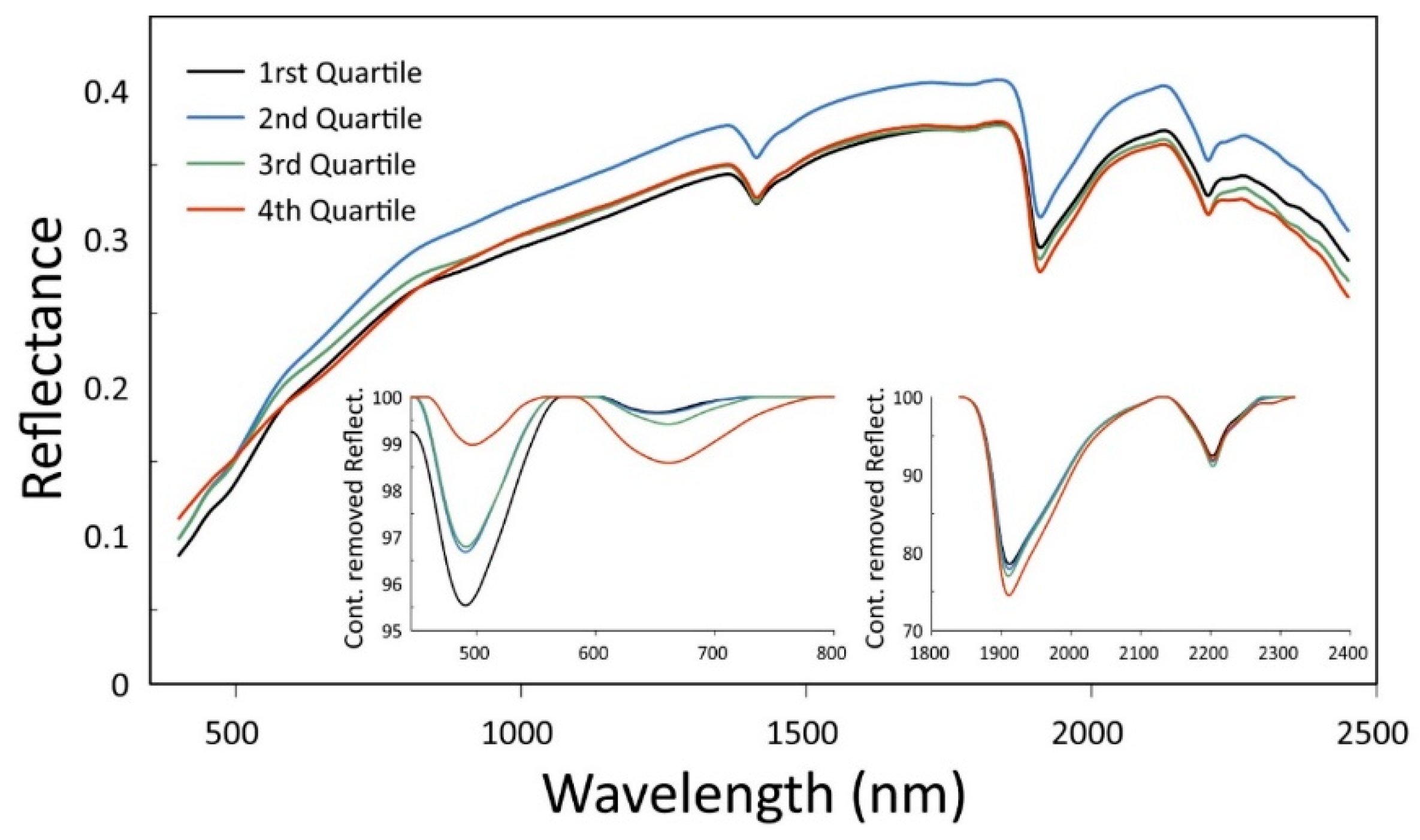
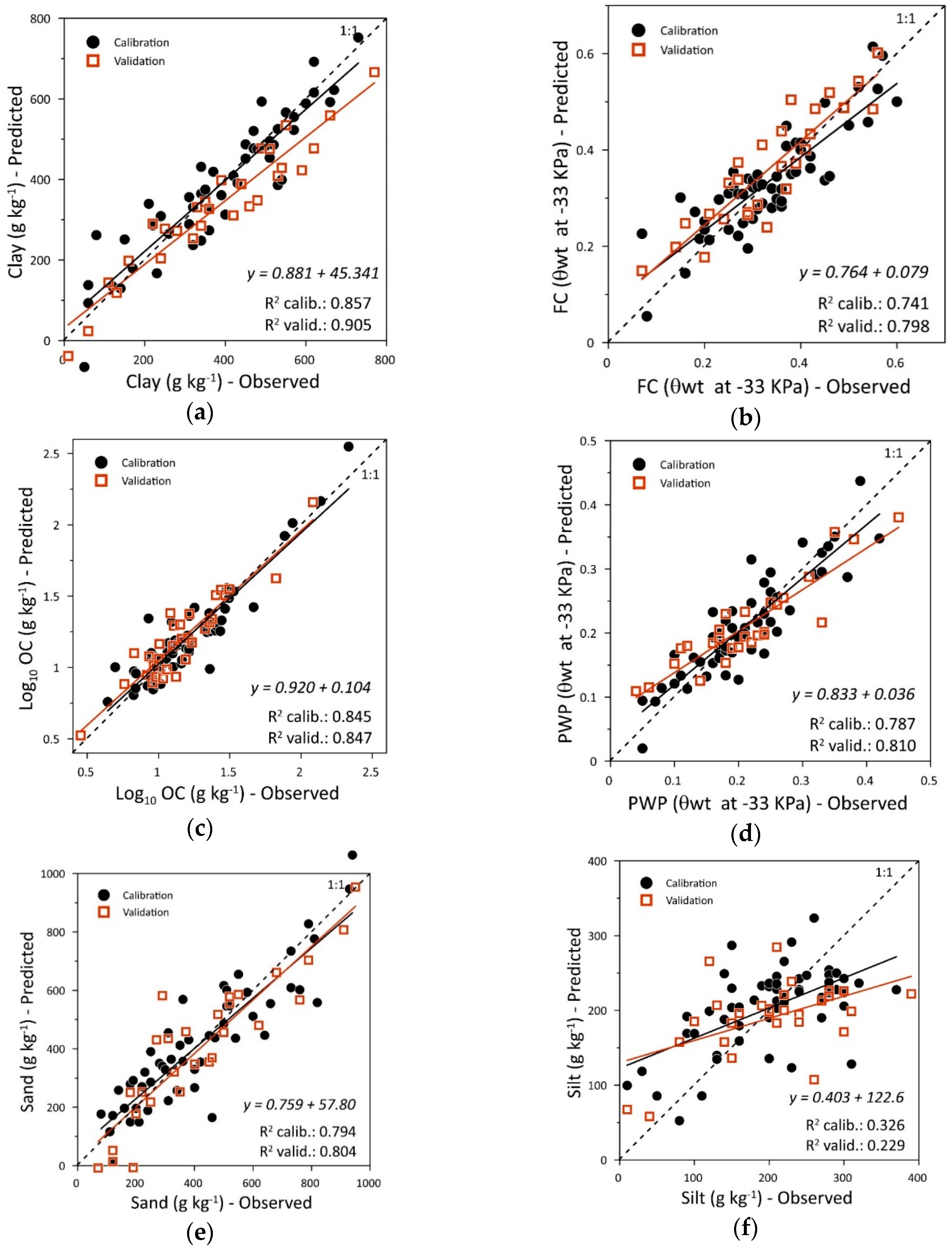
| n | Mean | Range | CV | Skewness | ||
|---|---|---|---|---|---|---|
| OC (g kg−1) | Calibration | 64 | 22.5 | 4.4–215.6 | 1.43 | 4.52 |
| Validation | 32 | 19.6 | 2.8–121.4 | 1.12 | 3.74 | |
| All data | 96 | 21.5 | 2.8–215.6 | 1.35 | 4.57 | |
| Sand (g kg−1) | Calibration | 54 | 419.8 | 80.0–940.0 | 0.53 | 0.59 |
| Validation | 28 | 423.6 | 70.0–950.0 | 0.56 | 0.64 | |
| All data | 82 | 421.1 | 70.0–950.0 | 0.54 | 0.60 | |
| Silt (g kg−1) | Calibration | 54 | 201.1 | 10.0–370.0 | 0.39 | −0.35 |
| Validation | 28 | 201.1 | 10.0–390.0 | 0.43 | −0.23 | |
| All data | 82 | 201.1 | 10.0–390.0 | 0.40 | −0.30 | |
| Clay (g kg−1) | Calibration | 54 | 377.4 | 50.0–730.0 | 0.46 | −0.14 |
| Validation | 28 | 378.9 | 10.0–770.0 | 0.50 | −0.09 | |
| All data | 82 | 377.7 | 10.0–770.0 | 0.47 | −0.12 | |
| FC (m3 m−3) | Calibration | 54 | 0.33 | 0.07–0.60 | 0.36 | 0.19 |
| Validation | 28 | 0.34 | 0.07–0.56 | 0.35 | −0.06 | |
| All data | 82 | 0.33 | 0.07–0.60 | 0.36 | 0.10 | |
| PWP (m3 m−3) | Calibration | 54 | 0.21 | 0.05–0.42 | 0.38 | 0.36 |
| Validation | 28 | 0.21 | 0.04–0.45 | 0.43 | 0.49 | |
| All data | 82 | 0.21 | 0.04–0.45 | 0.43 | 0.41 |
| OC | Sand | Silt | Clay | FC | |
|---|---|---|---|---|---|
| Sand | −0.337 ** | ||||
| Silt | 0.233 * | −0.691 *** | |||
| Clay | 0.317 ** | −0.942 *** | 0.408 *** | ||
| FC | 0.604 *** | −0.659 *** | 0.473 *** | 0.608 *** | |
| PWP | 0.615 *** | −0.679 *** | 0.467 *** | 0.639 *** | 0.959 *** |
| Clay | OC * | FC | PWP | |
|---|---|---|---|---|
| Slope I (400–700 nm) | – | 0.398 (l) | 0.199 (l) | 0.204 (l) |
| Slope II (400–600 nm) | – | 0.530 (l) | 0.243 (l) | 0.259 (l) |
| Slope III (500–700 nm) | – | 0.270 (l) | 0.202 (l) | 0.196 (l) |
| Slope IV (500–600 nm) | – | 0.580 (l) | 0.310 (l) | 0.317 (l) |
| Depth abs. band 660 nm | – | 0.561 (ex) | 0.171 (ex) | 0.212 (ex) |
| Depth abs. band 1900 nm | 0.417 (l) | – | 0.244 (l) | 0.296 (l) |
| Depth abs. band 2200 nm | 0.681 (l) | – | 0.147 (l) | 0.157 (l) |
| Soil Property | Calibration | Validation | |||||
|---|---|---|---|---|---|---|---|
| n. Fact. | R2adj | RMSE | RPD | R2adj | RMSE | RPD | |
| OC * | 8 | 0.845 | 0.124 | 2.52 | 0.847 | 0.122 | 2.50 |
| Sand | 7 | 0.794 | 100.71 | 2.22 | 0.804 | 106.37 | 2.24 |
| Silt | 4 | 0.326 | 64.40 | 1.23 | 0.229 | 74.38 | 1.16 |
| Clay | 5 | 0.857 | 64.80 | 2.69 | 0.905 | 56.71 | 3.33 |
| FC | 5 | 0.741 | 0.060 | 2.00 | 0.798 | 0.048 | 2.05 |
| PWP | 5 | 0.787 | 0.038 | 2.20 | 0.810 | 0.044 | 2.18 |
© 2019 by the authors. Licensee MDPI, Basel, Switzerland. This article is an open access article distributed under the terms and conditions of the Creative Commons Attribution (CC BY) license (http://creativecommons.org/licenses/by/4.0/).
Share and Cite
Leone, A.P.; Leone, G.; Leone, N.; Galeone, C.; Grilli, E.; Orefice, N.; Ancona, V. Capability of Diffuse Reflectance Spectroscopy to Predict Soil Water Retention and Related Soil Properties in an Irrigated Lowland District of Southern Italy. Water 2019, 11, 1712. https://doi.org/10.3390/w11081712
Leone AP, Leone G, Leone N, Galeone C, Grilli E, Orefice N, Ancona V. Capability of Diffuse Reflectance Spectroscopy to Predict Soil Water Retention and Related Soil Properties in an Irrigated Lowland District of Southern Italy. Water. 2019; 11(8):1712. https://doi.org/10.3390/w11081712
Chicago/Turabian StyleLeone, Antonio Pasquale, Guido Leone, Natalia Leone, Ciro Galeone, Eleonora Grilli, Nadia Orefice, and Valeria Ancona. 2019. "Capability of Diffuse Reflectance Spectroscopy to Predict Soil Water Retention and Related Soil Properties in an Irrigated Lowland District of Southern Italy" Water 11, no. 8: 1712. https://doi.org/10.3390/w11081712
APA StyleLeone, A. P., Leone, G., Leone, N., Galeone, C., Grilli, E., Orefice, N., & Ancona, V. (2019). Capability of Diffuse Reflectance Spectroscopy to Predict Soil Water Retention and Related Soil Properties in an Irrigated Lowland District of Southern Italy. Water, 11(8), 1712. https://doi.org/10.3390/w11081712







